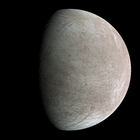Europa is the sixth-nearest and fourth-largest natural satellite of the planet Jupiter. Europa was discovered in 1610 by Galileo Galilei (and independently by Simon Marius), and named for a mythical Phoenician noblewoman, Europa, who was courted by Zeus. It is the smallest of the four Galilean moons - slightly smaller than Earth's Moon and is the sixth-largest moon in the Solar System. Europa has a tenuous atmosphere composed primarily of molecular oxygen. Its surface is composed of ice and is one of the smoothest in the Solar System. This young surface is striated by cracks and streaks, while craters are relatively infrequent. The apparent youth and smoothness of the surface have led to the hypothesis that a water ocean exists beneath it, which could conceivably serve as an abode for extraterrestrial life. Although by 2007 only flyby missions have visited the moon, the intriguing character of Europa has led to several ambitious exploration proposals. The Galileo mission provided the bulk of current data on Europa, while the Jupiter Icy Moons Orbiter, canceled in 2005, would have targeted Europa, Ganymede and Callisto. Conjecture on extraterrestrial life has ensured a high profile for the moon and has led to steady lobbying for future missions. (Full article...)
